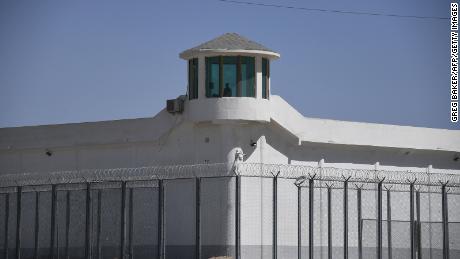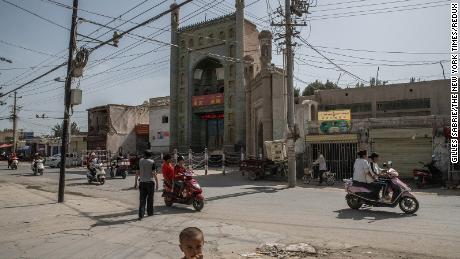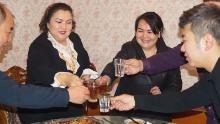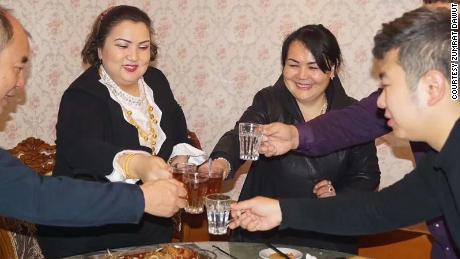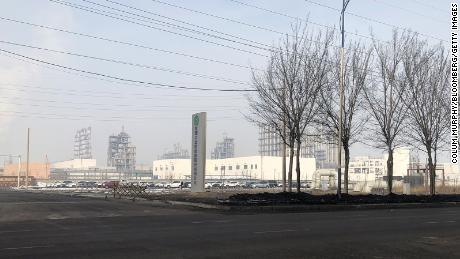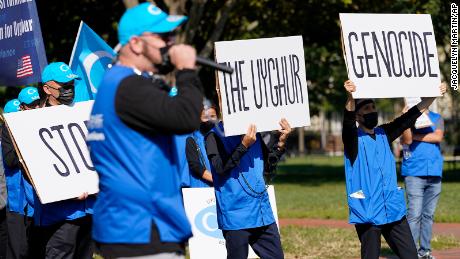Solar panels are key to Biden’s energy plan. But the global supply chain may rely on forced labor from China
But new research suggests that much of that work could rely on the exploitation of the region’s Uyghur population and other ethnic and religious minorities, potentially tainting a significant portion of the global supply chain for a renewable energy source critical to combating the climate crisis.
The Chinese Ministry of Foreign Affairs did not respond to a request for comment from CNN Business on the report. But asked Wednesday about allegations that forced labor in Xinjiang has tainted solar panel supply chains, Foreign Affairs spokesperson Hua Chunying called such claims “an outrageous lie.”
“A few Western countries and anti-China forces went all out to hype up the so-called ‘forced labor’ in Xinjiang’s cotton-growing industry. Now they are turning to the solar energy industry. Xinjiang cotton is speckless and solar energy is clean, but those in the US and the West who are hyping up the issue have a dark and sinister intention,” she told reporters. “They are trying to fabricate lies like ‘forced labor’ to create ‘forced industrial decoupling’ and ‘forced unemployment’ in Xinjiang to suppress Chinese companies and industries to serve their malicious agenda to mess up Xinjiang and contain China.”
“The global demand for solar energy has encouraged Chinese companies to go to great lengths to make our climate responsibility as inexpensive as possible,” the report states, “but it comes at great cost to the workers who labor at the origin of the supply chain.”
Revelations of the industry’s alleged ties to forced labor in Xinjiang could have huge consequences for those plans. There could also be implications for consumers and corporations that want to contribute to a greener future but may be unwittingly buying products that contain components made with forced labor and from electricity produced by burning dirty coal.
Solar panel companies in Xinjiang create “green energy by consuming cheap, carbon-emitting coal,” the report states. They also “sacrifice human labour conditions in the bargain,” it adds.
‘This wasn’t their way of life’
Beijing says the programs are necessary for alleviating poverty and tamping down religious extremism. But the researchers who compiled the report on solar panels said they are rooted in a darker truth.
“You have to understand that there’s really rabid racism in Xinjiang,” said Murphy, of Sheffield Hallam University. “The basic premise of these poverty alleviation programs is that Uyghur people cannot get themselves out of poverty, or that they want to be impoverished because they’ve been ideologically programmed to believe it’s better.”
The “labor transfer” programs also provide cheap labor to solar panel components suppliers, according to the report.
Murphy and Elimä said people from small Uyghur villages are forced to move hundreds or thousands of miles to do intense manual labor in industrial centers. After being relocated to work sites, adult couples are sometimes housed in dorm-like bunks with other workers, the report states, citing state media articles about surplus labor programs.
“This wasn’t their way of life before,” Elimä said. “We have our home, our garden, we’re living with our parents or sister … and now suddenly, someone is living in one city, their parents living in a nursing home, kids in a separate orphanage. What is going on here?”
Uyghur and other minority workers could put themselves and their families at risk of detention in an internment camp if they turn down or leave these labor placements, according to the report.
Tainted supply chains
One company, Xinjiang Hoshine Silicon Industry, is presented as a “case study” in the report for the trickle-down effect of alleged forced labor on the entire solar panel supply chain. Hoshine is the world’s largest producer of metallurgical-grade silicon, a component created from mined and crushed quartz which is then sold to leading polysilicon makers.
Government recruitment efforts on the company’s “behalf depend on coercive strategies that suggest non-voluntary labor,” the report states.
Manual laborers at Hoshine’s Xinjiang facility are paid to crush silicon manually at a rate of 42 Chinese yuan (around $6.50) per ton, the report states.
Hoshine did not respond to a request for comment on the report from CNN Business.
The process of purifying metallurgical-grade silicon into polysilicon requires extremely high temperatures and significant electricity consumption. This is another reason why Xinjiang — which has a large, government-subsidized coal industry — has become a solar components hub, according to the report.
Because Hoshine is one of the major raw materials suppliers in the area, the report claims that components allegedly made with forced labor at the company’s facility make their way into products sold by many other solar firms.
Daqo’s deputy chairman has pushed back on allegations that its own Xinjiang facility employs forced labor. In response to a request for comment from the researchers, Daqo’s board secretary and investor relations manager Kevin He said in an email Daqo does not participate in state-sponsored labor transfer programs, and that only 18 of the 2,021 employees at its Xinjiang facility are ethnic minorities.
But the report’s authors say that regardless of Daqo’s own practices, the company can’t vouch for its products because it buys raw materials from Hoshine.
“[Daqo’s] supply chain is tainted, and nobody’s going to look away from that anymore,” Murphy said.
Daqo’s He told the researchers that the company has “sent a formal statement to all of our suppliers in the Xinjiang region, clearly stating our stance of zero tolerance against forced labor, child labor, discrimination, sexual harassment, unfair and unequal treatment of employees.” All of the suppliers provided “formal written confirmation” that they do not engage in such practices, “which are also illegal in China,” He said.
“There is a very clear definition of ‘forced labor,'” He added. “We believe that one should not judge if there is forced labor or not simply by if a company has engaged in a particular program or has received certain types of subsidies. There should be clear evidence of violation for such claims to be made against a particular organization or individual.”
In response to questions from CNN Business, Daqo on Friday reiterated that it has informed its suppliers in Xinjiang — “including Hoshine” — of its zero tolerance policy. It added that Hoshine accounts for “approximately 30-35% of all the raw materials purchased including silicon powder and others.”
Daqo has contracts to sell polysilicon to the top four global producers of solar panels — China’s LONGi Green Energy Technology, JinkoSolar Holding, Trina Solar and JA Solar — among other companies, the report found. Daqo on Friday confirmed that those are its customers.
JinkoSolar is Daqo’s second largest customer, according to corporate documents cited in the report, and is one of the world’s largest producers of photovoltaic ingots, wafers and cells, products that make up solar panels (or “modules”). The company produces 42% of its ingots and wafers at its Xinjiang facility, the report states.
However, JinkoSolar’s US division noted that its products sold and installed in the United States do not include components or materials sourced from Xinjiang. JinkoSolar US has implemented measures to audit and review its supply chain “on an ongoing basis” and it has “a zero-tolerance policy for forced labor,” Ian McCaleb, a JinkoSolar US spokesperson, said in a statement to CNN Business.
“Jinko has undertaken a number of steps to ensure that the U.S. supply chain will use long-term, contracted polysilicon, and ingot, wafer, cell and assembly facilities from regions where the U.S. readily accepts independent audit results, therefore, Daqo Polysilicon is not part of Jinko’s U.S. supply chain,” McCaleb said. “Jinko strongly condemns the use of forced labor and does not engage in it in its hiring practices or workplace operations.”
Renewable power company sPower, which is listed as the owner of several of the solar farms using Jinko panels on JinkoSolar’s site, also reiterated that supplier qualification and traceability protocols implemented by JinkoSolar help ensure that no products sPower buys from it are jeopardized by forced labor in the supply chain.
“We are committed to working with solar module manufacturers that align with our principles and ethical standards, particularly in regards to human rights,” the AES Corporation, which owns sPower, said in a statement to CNN Business.
Of the other three major Daqo customers, only Trina has a manufacturing plant in Xinjiang, though it is unclear if the company participates in labor transfer programs, according to the report.
And even the companies that do not have facilities in Xinjiang, such as LONGi and JA Solar, may be tainted because they source polysilicon from Daqo, which runs a factory in the region and buys raw materials from Hoshine.
Trina, LONGi, JA Solar and JinkoSolar’s headquarters in China did not respond to requests for comment on the report from CNN Business.
“It is unethical to continue investing there,” Elimä said. “You can’t do business with a country that has internment camps, especially when you know there is a camp in that region.”
International response
Solar power is central to US President Joe Biden’s plans to transition the United States to a greener energy grid.
The accelerating adoption of solar raises the stakes for ensuring that the industry’s supply chain does not involve forced labor.
Since the bill’s introduction, solar trade group the Solar Energy Industries Association (SEIA) has urged US solar companies to avoid sourcing components from Xinjiang, according to John Smirnow, the association’s vice president of market strategy.
“There have been concerns about forced labor tied to the solar supply chain [in Xinjiang] … it makes products from that region very high risk,” Smirnow told CNN Business. “The only way to address that risk is to show that there is no forced labor, but you need an independent, third party audit to do that, which you can’t do in the region.”
“We wanted to give our companies a tool to provide assurances that the goods being imported in the US don’t include inputs from the [Xinjiang] region and don’t include inputs produced with forced labor,” Smirnow said.
The commitments suggest “a nearly industry-wide commitment to addressing the problems,” raised in the new report. But many of the signatories “would have to make significant changes to ensure that they are not purchasing raw materials made with Xinjiang forced labor,” it states.
The report is intended in part to help companies implementing the SEIA’s protocol to identify potential issues in their supply chains, the authors said.
Experts say there are solar panel components suppliers outside of Xinjiang, and even outside China, that could help meet the needs of the United States and Europe, where governments and industry have expressed concerns about the use of forced labor and where there is greater political pressure to challenge Beijing. But these sources could be more expensive, given the Chinese subsidies and other benefits offered for operating in Xinjiang.
In response to a request for comment about whether JinkoSolar has any plans to stop operating or sourcing components from Xinjiang, McCaleb, the JinkoSolar US spokesperson, reiterated that the supply chain for the company’s US division does not source components from Xinjiang. He added: “Jinko has a strong track record of industry-leading workplace practices, which include employment at will, universal premium pay and benefits, and scheduled leave for all employees at our factories.”
As the Biden administration considers how to expand the use of green energy in the United States, the researchers and the SEIA’s Smirnow said investing in US solar panel components manufacturing could be a way to ensure that growth happens responsibly.
“So long as the Chinese government is running internment camps and forced labor programs in Xinjiang, no company should have a factory or a subsidiary there,” Murphy said. “Period.”
Additional reporting by Rebecca Wright, Selina Wang and Ben Westcott.
![]()




